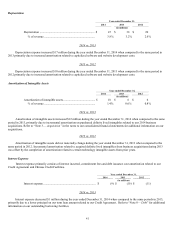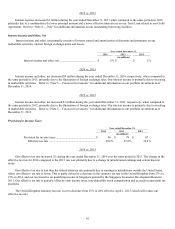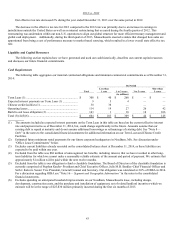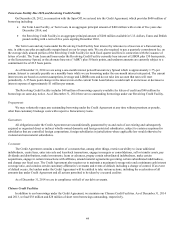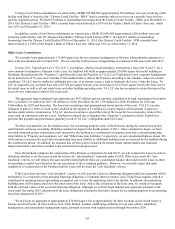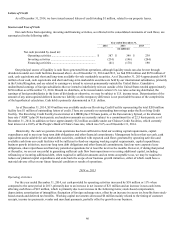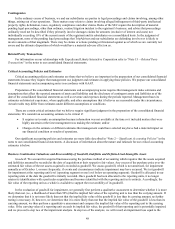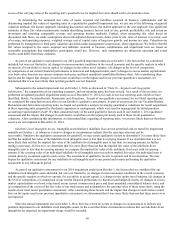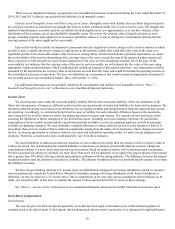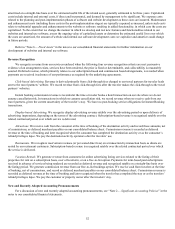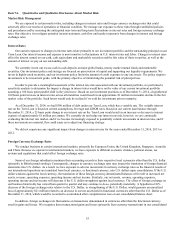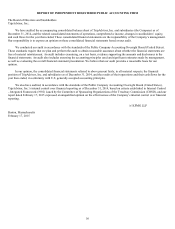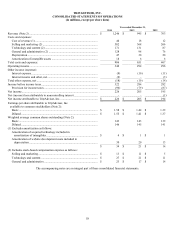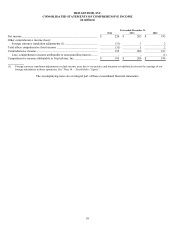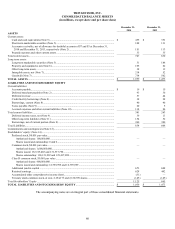TripAdvisor 2014 Annual Report Download - page 60
Download and view the complete annual report
Please find page 60 of the 2014 TripAdvisor annual report below. You can navigate through the pages in the report by either clicking on the pages listed below, or by using the keyword search tool below to find specific information within the annual report.50
There were no impairment charges recognized to our consolidated statement of operations during the years ended December 31,
2014, 2013 and 2012 related to our goodwill and indefinite lived intangible assets.
Definite-Lived Intangible Assets and Other Long-Lived Assets. Intangible assets with definite lives and other long-lived assets
are carried at cost and are amortized on a straight-line basis over their estimated useful lives of two to twelve years. The straight-line
method of amortization is currently used for our definite-lived intangible assets as it approximates, or is our best estimate, of the
distribution of the economic use of our identifiable intangible assets. We review the carrying value of long-lived assets or asset
groups, including property and equipment, to be used in operations whenever events or changes in circumstances indicate that the
carrying amount of the assets might not be recoverable.
Factors that would necessitate an impairment assessment include a significant adverse change in the extent or manner in which
an asset is used, a significant adverse change in legal factors or the business climate that could affect the value of the asset, or a
significant decline in the observable market value of an asset, among others. If such facts indicate a potential impairment, we assess
the recoverability of the asset by determining if the carrying value of the asset exceeds the sum of the projected undiscounted cash
flows expected to result from the use and eventual disposition of the asset over the remaining economic life of the asset. If the
recoverability test indicates that the carrying value of the asset is not recoverable, we will estimate the fair value of the asset using
appropriate valuation methodologies which would typically include an estimate of discounted cash flows. Any impairment would be
measured by the amount that the carrying value of such assets exceeds their fair value and would be included in operating income on
the consolidated statement of operations. We have not identified any circumstances that would warrant an impairment assessment of
any recorded assets in our consolidated balance sheet at December 31, 2014.
For additional information on our goodwill, indefinite-lived intangibles and definite-lived intangibles refer to “Note 7—
Goodwill and Intangible Assets, net” in the notes to our consolidated financial statements.
Income Taxes
We record income taxes under the asset and liability method. Deferred tax assets and liabilities reflect our estimation of the
future tax consequences of temporary differences between the carrying amounts of assets and liabilities for book and tax purposes. We
determine deferred income taxes based on the differences in accounting methods and timing between financial statement and income
tax reporting. Accordingly, we determine the deferred tax asset or liability for each temporary difference based on the enacted tax
rates expected to be in effect when we realize the underlying items of income and expense. We consider all relevant factors when
assessing the likelihood of future realization of our deferred tax assets, including our recent earnings experience by jurisdiction,
expectations of future taxable income and the carryforward periods available to us for tax reporting purposes, as well as assessing
available tax planning strategies. We may establish a valuation allowance to reduce deferred tax assets to the amount we believe is
more likely than not to be realized. Due to inherent complexities arising from the nature of our businesses, future changes in income
tax law, tax sharing agreements or variances between our actual and anticipated operating results, we make certain judgments and
estimates. Therefore, actual income taxes could materially vary from these estimates.
We record liabilities to address uncertain tax positions we have taken in previously filed tax returns or that we expect to take in
a future tax return. The determination for required liabilities is based upon an analysis of each individual tax position, taking into
consideration whether it is more likely than not that our tax position, based on technical merits, will be sustained upon examination.
For those positions for which we conclude it is more likely than not it will be sustained, we recognize the largest amount of tax benefit
that is greater than 50% likely of being realized upon ultimate settlement with the taxing authority. The difference between the amount
recognized and the total tax position is recorded as a liability. The ultimate resolution of these tax positions may be greater or less than
the liabilities recorded.
We have not provided for deferred U.S. income taxes on undistributed earnings of our foreign subsidiaries, which we intend to
reinvest permanently outside the United States. Should we distribute earnings of foreign subsidiaries in the form of dividends or
otherwise, we may be subject to U.S. income taxes. Due to complexities in tax laws and various assumptions that would have to be
made, it is not practicable, at this time, to estimate the amount of unrecognized deferred U.S. taxes on these earnings.
See “Note 9— Income Taxes” in the notes to our consolidated financial statements for further information on income taxes.
Stock-Based Compensation
Stock Options
The exercise price for all stock options granted by us to date has been equal to the market price of the underlying shares of
common stock at the date of grant. In this regard, when making stock option awards, our practice is to determine the applicable grant



